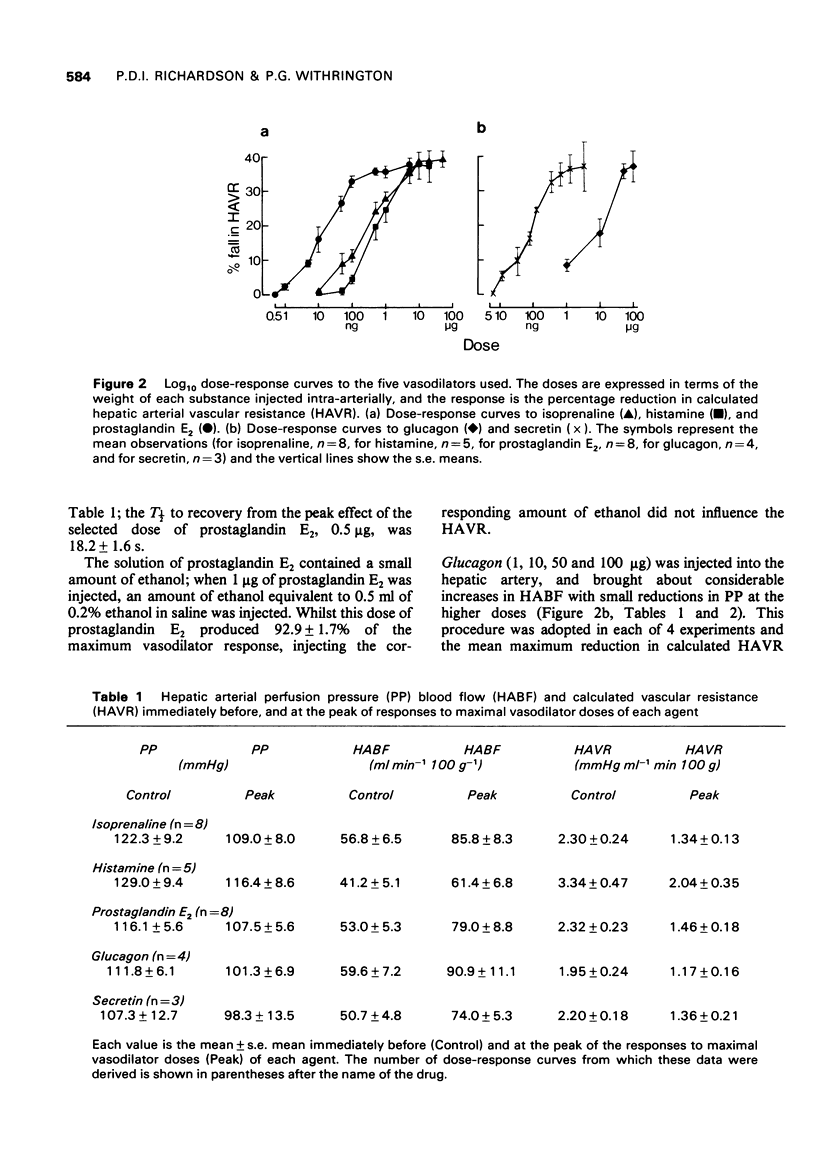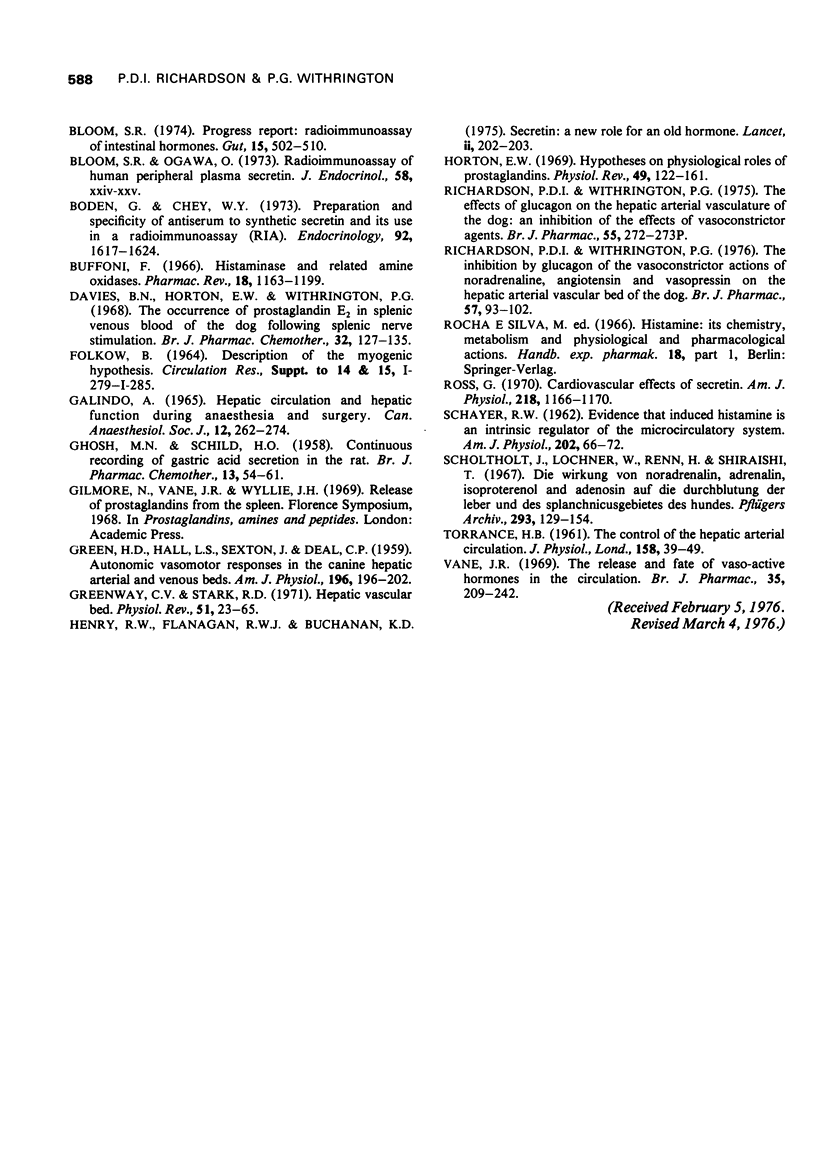Abstract
The sympathetically-innervated arterial vascular bed of the dog's liver was perfused from a femoral artery. Arterial blood flow and perfusion pressure were measured continuously, and the hepatic arterial vascular resistance calculated. The preparation provided a means of assessing hepatic arterial vasodilatation quantitatively. 2 Isoprenaline, histamine, prostaglandin E2, glucagon and secretin were injected intra-arterially and all evoked dose-dependent vasodilatation of the hepatic arterial vascular bed. 3 The maximum reduction in the calculated hepatic arterial vascular resistance of 37-38% was the same for each of the five substances. 4 Comparisons on a weight basis revealed that prostaglandin E2 was the most potent, followed in potency order by secretin, isoprenaline, histamine and glucagon. 5 Comparisons on a molar basis showed that secretin and prostaglandin E3 were intrinsically considerably more potent than isoprenaline, histamine or glucagon. 6 The onset of the vasodilatator responses to secretin, isoprenaline, histamine and prostaglandin E2, was rapid, and the duration of their actions was brief. 7 The onset of the vasodilator effects of glucagon was slow and its duration of action very prolonged. 8 The implications of these observations with respect to the physiological control of the hepatic arterial vascular bed of the dog are discussed.
Full text
PDF







Selected References
These references are in PubMed. This may not be the complete list of references from this article.
- Bayliss W. M. On the local reactions of the arterial wall to changes of internal pressure. J Physiol. 1902 May 28;28(3):220–231. doi: 10.1113/jphysiol.1902.sp000911. [DOI] [PMC free article] [PubMed] [Google Scholar]
- Bayliss W. M., Starling E. H. The mechanism of pancreatic secretion. J Physiol. 1902 Sep 12;28(5):325–353. doi: 10.1113/jphysiol.1902.sp000920. [DOI] [PMC free article] [PubMed] [Google Scholar]
- Beck L. Histamine as the potential mediator of active reflex dilatation. Fed Proc. 1965 Nov-Dec;24(6):1298–1310. [PubMed] [Google Scholar]
- Best C. H., Dale H. H., Dudley H. W., Thorpe W. V. The nature of the vaso-dilator constituents of certain tissue extracts. J Physiol. 1927 Mar 15;62(4):397–417. doi: 10.1113/jphysiol.1927.sp002369. [DOI] [PMC free article] [PubMed] [Google Scholar]
- Bloom S. R., Ogawa O. Radioimmunoassay of human peripheral plasma secretin. J Endocrinol. 1973 Jul;58(1):xxiv–xxv. [PubMed] [Google Scholar]
- Bloom S. R. Progress report. Radioimmunoassay of intestinal hormones. Gut. 1974 Jun;15(6):502–510. doi: 10.1136/gut.15.6.502. [DOI] [PMC free article] [PubMed] [Google Scholar]
- Boden G., Chey W. Y. Preparation and specificity of antiserum to synthetic secretin and its use in a radioimmunoassay (RIA). Endocrinology. 1973 Jun;92(6):1617–1624. doi: 10.1210/endo-92-6-1617. [DOI] [PubMed] [Google Scholar]
- Buffoni F. Histaminase and related amine oxidases. Pharmacol Rev. 1966 Dec;18(4):1163–1199. [PubMed] [Google Scholar]
- Davies B. N., Horton E. W., Withrington P. G. The occurrence of prostaglandin E2 in splenic venous blood of the dog following splenic nerve stimulation. Br J Pharmacol Chemother. 1968 Jan;32(1):127–135. doi: 10.1111/j.1476-5381.1968.tb00436.x. [DOI] [PMC free article] [PubMed] [Google Scholar]
- GALINDO A. HEPATIC CIRCULATION AND HEPATIC FUNCTION DURING ANAESTHESIA AND SURGERY. Can Anaesth Soc J. 1965 May;12:262–274. doi: 10.1007/BF03004141. [DOI] [PubMed] [Google Scholar]
- GHOSH M. N., SCHILD H. O. Continuous recording of acid gastric secretion in the rat. Br J Pharmacol Chemother. 1958 Mar;13(1):54–61. doi: 10.1111/j.1476-5381.1958.tb00190.x. [DOI] [PMC free article] [PubMed] [Google Scholar]
- GREEN H. D., HALL L. S., SEXTON J., DEAL C. P. Autonomic vasomotor responses in the canine hepatic arterial and venous beds. Am J Physiol. 1959 Jan;196(1):196–202. doi: 10.1152/ajplegacy.1958.196.1.196. [DOI] [PubMed] [Google Scholar]
- Greenway C. V., Stark R. D. Hepatic vascular bed. Physiol Rev. 1971 Jan;51(1):23–65. doi: 10.1152/physrev.1971.51.1.23. [DOI] [PubMed] [Google Scholar]
- Henry R. W., Flanagan R. W., Buchanan K. D. Secretin: A new role for an old hormone. Lancet. 1975 Aug 2;2(7927):202–203. doi: 10.1016/s0140-6736(75)90672-8. [DOI] [PubMed] [Google Scholar]
- Horton E. W. Hypotheses on physiological roles of prostaglandins. Physiol Rev. 1969 Jan;49(1):122–161. doi: 10.1152/physrev.1969.49.1.122. [DOI] [PubMed] [Google Scholar]
- Richardson P. D., Withrington P. G. Proceedings: The effects of glucagon on the hepatic arterial vasculature of the dog: an inhibition of the effects of vasoconstrictor agents. Br J Pharmacol. 1975 Oct;55(2):272P–273P. [PMC free article] [PubMed] [Google Scholar]
- Richardson P. D., Withrington P. G. The inhibition by glucagon of the vasoconstrictor actions of noradrenaline, angiotensin and vasopressin on the hepatic arterial vascular bed of the dog. Br J Pharmacol. 1976 May;57(1):93–102. doi: 10.1111/j.1476-5381.1976.tb07659.x. [DOI] [PMC free article] [PubMed] [Google Scholar]
- Ross G. Cardiovascular effects of secretin. Am J Physiol. 1970 Apr;218(4):1166–1170. doi: 10.1152/ajplegacy.1970.218.4.1166. [DOI] [PubMed] [Google Scholar]
- SCHAYER R. W. Evidence that induced histamine is an intrinsic regulator of the microcirculatory system. Am J Physiol. 1962 Jan;202:66–72. doi: 10.1152/ajplegacy.1962.202.1.66. [DOI] [PubMed] [Google Scholar]
- Scholtholt J., Lochner W., Renn H., Shiraishi T. Die Wirkung von Noradrenalin, Adrenalin, Isoproterenol und Adenosin auf die Durchblutung der Leber und des Splanchnicusgebietes des Hundes. Pflugers Arch Gesamte Physiol Menschen Tiere. 1967;293(2):129–154. [PubMed] [Google Scholar]
- TORRANCE H. B. The control of the hepatic arterial circulation. J Physiol. 1961 Sep;158:39–49. doi: 10.1113/jphysiol.1961.sp006752. [DOI] [PMC free article] [PubMed] [Google Scholar]
- Vane J. R. The release and fate of vaso-active hormones in the circulation. Br J Pharmacol. 1969 Feb;35(2):209–242. doi: 10.1111/j.1476-5381.1969.tb07982.x. [DOI] [PMC free article] [PubMed] [Google Scholar]


